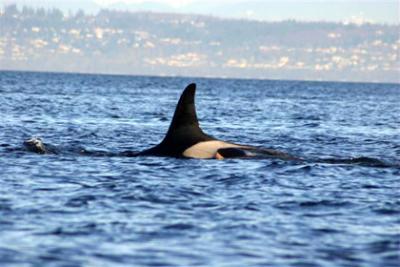
Sooke (L112)

Last February, we mourned the loss of Ruffles (J1), the eldest Southern Resident male orca. This February we mourn for departed youngsters. Precious little female Sooke (L112), 2009 – 2012, stranded at Long Beach, WA on February 11 and the new calf in J Pod, J48, is missing and probably dead.
L112’s cause of death is undetermined. An internal exam "revealed significant trauma around the head, chest and right side; at this point the cause of these injuries is unknown," according to the necropsy report posted at cascadiaresearch.org. What is disturbing is that exposure to sonar or blast trauma are potential culprits for her injury pattern. Additional analysis of samples is required to verify how she died.
A Canadian Navy vessel plowed through Haro Strait blasting mid-frequency sonar early on the morning of February 6. Hydrophones on the west side of San Juan Island and at Port Townsend detected the sonar pings -- see orcasound.net. Endangered Southern Resident and Transient killer whales were both in the area during the 24-hour period before and after the sonar incident. Stay tuned.
Sooke’s loss is particularly ominous because L Pod desperately needs females. L Pod’s family tree is alarming. Several L Pod matrilines will die out from absence of any females or lack of reproductive females.
This week’s photo pays tribute to a cherished life cut short. In February 2009, when she was just weeks old, Mark Sears took this intimate photo of Sooke (L112) snuggled up to her mother Surprise! (L86). Sooke was likely still nursing at the time of her death.
Between February 5 and February 10, Vashon Hydrophone Project (VHP) associates documented three remarkable killer whale encounters in Vashon-Maury waters. On February 5, a group of 15 Transient orcas cruised north in Colvos Pass. I spotted some familiar whales among them. Matriarch T124, about 45 years old, and her offspring have visited Island waters regularly since 2008. T100, 34-ish, and her offspring are also return visitors. The Transients traveled precariously close to four Dall’s porpoises and a Steller’s sea lion – potential prey species. That may account for why the stealth hunters were silent on the hydrophone.
On February 9 and 10, an intriguing combination of 13 Southern Resident orcas traveled slowly up and down East Passage. On February 9, the four K Pod members and nine L Pod members meandered south through the Vashon-Fauntleroy ferry lanes and then changed direction at Dilworth by late morning, traveling north toward Bainbridge in the afternoon. Based on observed behavior, reports from VHP spotters, and the orcas’ exceedingly slow pace, it is possible that these whales were traveling with a newborn. We urge anyone with decent orca photos from February 9 or 10 to email images to Vashonorcas@aol.com or call 463-9041.
Odin and I saw the 13 orcas at Point Robinson on February 10 but could not confirm the presence of a newborn. L Pod whales were closer to the point: L2 (Grace) and her sons L78 (Gaia) and L88 (Wave Walker); female L5 (Tanya) with male L84 (Nyssa); Ino (L54) and her three offspring L100 (Indigo), age 11, L108 (Coho), age 6, and L117, born in 2010.
The youngest whale observed in the group of 13 was L117. L117 still has faintly peach-tinged white markings and is about the size of Springer when she was here in 2002. A newborn would be noticeably smaller, with bright peach markings.
Whether or not the K Pod orcas farther offshore had a newborn with them remains a mystery. The younger K Pod female in the group, 27 year-old K16 (Opus), is a viable candidate for prospective Mom. She has a son K35 (Sonata), age 10. Sister and brother K40 (Raggedy) and K21 (Cappuccino) were also in the mix.
Three females in this grouping are close to age 50 and allegedly post-reproductive: L2 (Grace), L5 (Tanya), and K40 (Raggedy). Raggedy, 48-ish, has never been seen with her own calf. Sometimes these older gals give birth but the babies do not survive.
So far, we have only seen photos of the L Pod members who were here on February 9 and 10. L112’s (Sooke’s) immediate family members were not among them. The 13 Southern Residents did not venture into Colvos Pass; they departed Vashon-Maury waters by February 11.
Please support the work of the Vashon Hydrophone Project (VHP): REPORT LOCAL WHALE SIGHTINGS ASAP TO 463-9041. We are deeply grateful to ferry riders, crew, and Islanders who call us directly. Your timely reports are tremendously helpful to our on-Island research effort. VHP associates are your neighbors, with decades of experience observing and documenting orcas and other marine mammals in Island waters. The VHP collects acoustic, photographic, and observational data in a precautionary, sustainable manner and does not endorse invasive methodology for studying endangered orcas. Call the VHP about seal pups as well as dead, injured, or sick marine mammals on Island beaches. Check for updates at www.Vashonorcas.org and send photos to Orca Annie at Vashonorcas@aol.com.
- Login to post comments
